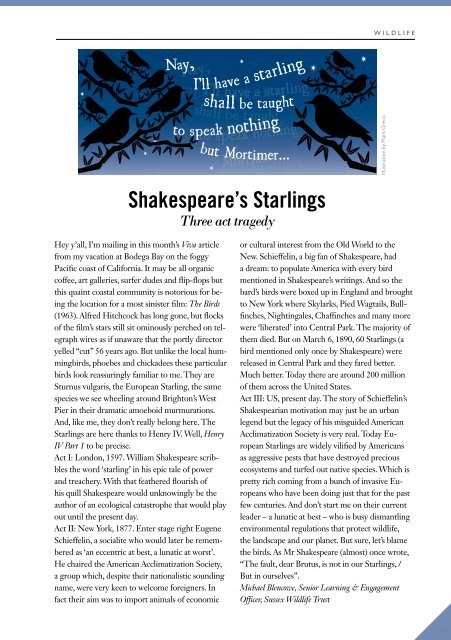You also want an ePaper? Increase the reach of your titles
YUMPU automatically turns print PDFs into web optimized ePapers that Google loves.
WILDLIFE<br />
Illustration by Mark Greco<br />
Shakespeare’s Starlings<br />
Three act tragedy<br />
Hey y’all, I’m mailing in this month’s <strong>Viva</strong> article<br />
from my vacation at Bodega Bay on the foggy<br />
Pacific coast of California. It may be all organic<br />
coffee, art galleries, surfer dudes and flip-flops but<br />
this quaint coastal community is notorious for being<br />
the location for a most sinister film: The Birds<br />
(1963). Alfred Hitchcock has long gone, but flocks<br />
of the film’s stars still sit ominously perched on telegraph<br />
wires as if unaware that the portly director<br />
yelled “cut” 56 years ago. But unlike the local hummingbirds,<br />
phoebes and chickadees these particular<br />
birds look reassuringly familiar to me. They are<br />
Sturnus vulgaris, the European Starling, the same<br />
species we see wheeling around Brighton’s West<br />
Pier in their dramatic amoeboid murmurations.<br />
And, like me, they don’t really belong here. The<br />
Starlings are here thanks to Henry IV. Well, Henry<br />
IV Part 1 to be precise.<br />
Act I: London, 1597. William Shakespeare scribbles<br />
the word ‘starling’ in his epic tale of power<br />
and treachery. With that feathered flourish of<br />
his quill Shakespeare would unknowingly be the<br />
author of an ecological catastrophe that would play<br />
out until the present day.<br />
Act II: New York, 1877. Enter stage right Eugene<br />
Schieffelin, a socialite who would later be remembered<br />
as ‘an eccentric at best, a lunatic at worst’.<br />
He chaired the American Acclimatization Society,<br />
a group which, despite their nationalistic sounding<br />
name, were very keen to welcome foreigners. In<br />
fact their aim was to import animals of economic<br />
or cultural interest from the Old World to the<br />
New. Schieffelin, a big fan of Shakespeare, had<br />
a dream: to populate America with every bird<br />
mentioned in Shakespeare’s writings. And so the<br />
bard’s birds were boxed up in England and brought<br />
to New York where Skylarks, Pied Wagtails, Bullfinches,<br />
Nightingales, Chaffinches and many more<br />
were ‘liberated’ into Central Park. The majority of<br />
them died. But on March 6, 1890, 60 Starlings (a<br />
bird mentioned only once by Shakespeare) were<br />
released in Central Park and they fared better.<br />
Much better. Today there are around 200 million<br />
of them across the United States.<br />
Act III: US, present day. The story of Schieffelin’s<br />
Shakespearian motivation may just be an urban<br />
legend but the legacy of his misguided American<br />
Acclimatization Society is very real. Today European<br />
Starlings are widely vilified by Americans<br />
as aggressive pests that have destroyed precious<br />
ecosystems and turfed out native species. Which is<br />
pretty rich coming from a bunch of invasive Europeans<br />
who have been doing just that for the past<br />
few centuries. And don’t start me on their current<br />
leader – a lunatic at best – who is busy dismantling<br />
environmental regulations that protect wildlife,<br />
the landscape and our planet. But sure, let’s blame<br />
the birds. As Mr Shakespeare (almost) once wrote,<br />
“The fault, dear Brutus, is not in our Starlings, /<br />
But in ourselves”.<br />
Michael Blencowe, Senior Learning & Engagement<br />
Officer, Sussex Wildlife Trust<br />
105

















